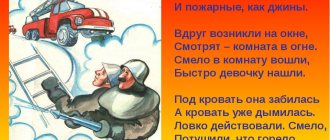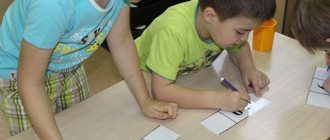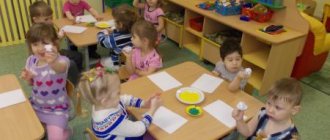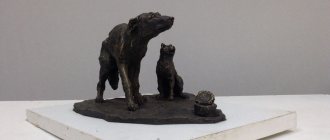Summary of educational activities for the development of self-service skills
Summary of educational activities for the development of self-service skills
Target:
Continue to teach children to independently care for their appearance and the condition of their clothing.
Tasks:
1. Strengthening children’s ability to put things back in their place
2. Formation of clothing care skills;
3. Formation of a desire for neatness; to the ability to notice and correct imperfections in appearance in oneself and other children;
4. Improving the ability to dress independently in the correct sequence;
5. Enrichment of vocabulary with the help of proverbs and sayings on the topic
Progress of the lesson
There's a knock on the door.
Educator:
Children, do you hear, someone came to visit us. Vika, let's go, open the door and meet the guest.
(An upset Luntik enters the group, introduces himself, begins to take off his outerwear and throws things around as he goes.)
Educator:
Hello! What happened, why are you so upset?
Luntik:
"Hello! My name is Luntik. My friends don't invite me to go out with them! So I'm upset. They say I'm sloppy, sloppy! Guys, tell me what these words are, what do they mean? I came to you for help, you know everything in kindergarten and can do everything!
Educator:
Luntik, we will help you! First, children, let's remember what these words mean - sloppy, sloppy?
(This is a person who does not keep his things orderly and clean and does not take care of his appearance.)
What did Luntik do wrong when he joined our group? (Scattered his things.) Let's tell you what you really need to do with them.
Children's individual answers:
- put the boots on the shoe rack,
- hang the jacket on a hook in the locker,
- Put the hat on the top shelf in the locker.
Educator:
And now Vanya and Polina will help me put Luntik’s things back in their places.
So that our advice is not forgotten, remember the proverbs and sayings about neatness that our children know.
Timur:
“The whole world is kept up by neatness”
Masha:
“Where there is neatness, there is neatness”
Seva:
“Whoever is neat is pleasant to people.”
Educator:
All things need to be looked after not only when they are old, but also when they are still new.
Luntik:
Oh, I still have a lot of things here! They're all mixed up and I don't know what to do with them! Teach me how to lay things out! (Pours things out of the bag.)
Several children help Luntik sort things into pairs, and neatly fold unpaired things or hang them on a chair.
Educator:
And our children also know that they need to not only carefully put things in their places, but also wear them carefully and take care of their appearance. Guys, let's look at our guest - what's wrong with his clothes?
(Children notice flaws in the doll’s clothes, and take turns going out to correct them)
- different socks,
- shoes on the wrong foot,
- shirt inside out.
Educator:
Remember one more lesson - “They are greeted by their clothes, but they are seen off by their minds” - this means that first of all people pay attention to the appearance of other people, their clothes, and only then to everything else.
Luntik:
Well done! Guys, you really know everything! You helped me a lot. But I want to see - do you know how to do all this yourself? I'll give you a test - who will dress correctly for a walk?
(The teacher selects 2 children who will show how they know how to dress. The test is carried out several times.)
Luntik:
Well done boys! Now I also know how to dress properly!
Educator
: So we helped Luntik! I hope now he won’t have any problems, and his friends will always invite him for a walk! Guys, let's remember what we taught our guest today? What proverbs and sayings does Luntik need to remember?
Luntik:
Thanks guys, you helped me a lot! I will remember your advice!
Household work in the senior group
The teacher invites the children to sit on chairs placed in a semicircle on the carpet. Suggests considering the following constructors:-Guys, what kind of constructor do we have in our group? (large, medium, small). How are they different from each other? (varies in size).
-Guys, how are we going to wash the construction set? What will we do first? What will we do next?
The teacher listens to the children's answers and offers to tell the sequence of actions.
-Guys. Let's show and tell you how we will wash our constructor.
The teacher offers to talk and show one child a sample action for washing toys (1 child - 1 piece of construction set).
—
Guys, what tools will we use?
The teacher draws the children's attention to the table.
—
What tools do you see? (rag, container with water - basin, detergent - soap, watering can). What are they for?
- Guys, do we need all the tools to wash the toys?
-What's extra? Why?
-Where can we use the watering can?
-That's right, we can use the watering can in caring for plants, but we won't need it for washing toys, let's put it away.
-Do we need all the other tools? Do we leave them?
- Guys, but in order to operate with tools, we must remember the safety rules.
A bowl of water - you can spill water, but what happens if we spill water?
The teacher listens to the children's answers.
Soap, soapy rag - what will happen if we throw them?
The teacher listens to the children's answers.
-Guys, everything will be fine if we follow the rules of behavior and help each other.
-Guys, we need to wash several types of construction sets, and to do this faster, I suggest you unite in teams. Look, multi-colored cards are attached to our construction sets, and on my table there are multi-colored cards, but turned over with the colored side down. I suggest you take turns choosing a card and going to the constructor on which the designation is the same color as yours. The teacher observes the unification of children using lots.
Guys, look carefully, your cards indicate not only the construction set, but also the tool with which you will work, find and put it next to your workplace.
- Guys, we looked at what construction sets we have in our group, remembered how to wash them, chose tools, remembered safety precautions, united into teams and distributed responsibilities among ourselves, we are ready to work, all we have to do is put on our aprons.
Open lesson with children of the middle group “Self-care skills”
Goal: Continue to teach children to independently care for their appearance and the condition of their clothing.
Tasks:
1. Strengthening children’s ability to put things back in their place
2. Formation of clothing care skills;
3. Formation of a desire for neatness; to the ability to notice and correct imperfections in appearance in oneself and other children;
4. Improving the ability to dress independently in the correct sequence;
5. Enrichment of vocabulary with the help of proverbs and sayings on the topic
Progress of the lesson
Educator: Children, this morning we received a letter, unsigned, no return address. Let’s read what is written there: “Hello! I need your help! I’ll come in the morning!”
Very interesting! (intercom ringing) And here, probably, is our guest!
(A doll enters the group, introduces itself, begins to take off its outerwear and scatters things as it goes.)
Doll: “Hello! My name is Katya doll. I'm upset. My girlfriends don't invite me to their place! They say I'm sloppy, sloppy! What kind of words are these, what do they mean? And what should I do now? You know everything here, so I decided to turn to you for help!
Educator: We know, Katya, how to help you! First of all, children, what do these words mean - sloppy, slob? (This is a person who does not take care of his things and his appearance.)
What did Katya do wrong when she entered? (She scattered her things.) Let's tell you what you really need to do with them.
Children's individual answers:
- put the boots under the bench,
- hang the jacket on a hanger,
- put the hat on the shelf.
the teacher helps put their outerwear back in its place. “So that our advice is not forgotten, remember the proverbs and sayings about neatness that our children know. Misha S. “Take care of the dress from new” (“means that all things need to be looked after not only when they are old, but also when they are still new”).
Doll: Oh, I still have a lot of things here! They're all mixed up and I don't know what to do with them! Teach me how to lay things out! (Pours things out of the bag.)
Children: Several children help the doll sort things into pairs, and neatly fold unpaired things or hang them on a chair.
Educator: “Things need to be put away, so you don’t have to look for them.” Children, you know that things need not only to be neatly put in their places, but also to be worn carefully and to take care of your appearance. Look at our guest - what's wrong with her outfit?
(Children notice flaws in the doll’s clothes, and take turns going out to correct them
- untied bow on the head,
- socks of different colors,
- slippers on the wrong foot,
- the blouse is not tucked in completely.)
Educator: Remember one more lesson - “They are greeted by their “clothes”, and seen off by their minds” (means that first of all people pay attention to the appearance of other people, to their “Clothes”, and only then to everything else).
Doll: Well done! Yes, you know a lot! You told me everything, and now I want to see - do you know how to do all this yourself? I'll give you a test - who will dress correctly for a walk?
(The teacher selects 2 children who will show how they know how to dress. And the rest come to the table, where cards with pictures of clothes are laid out, and show them in the correct sequence.)
Doll: Well done, guys! Now I also know how to dress properly!
Educator : So we helped the doll Katya! I hope she doesn't have any problems now! Let's remember what we taught our guest today? What proverbs and sayings does Katya need to remember?
Katya: Thank you guys, you helped me a lot! I will remember your advice!
Summary of self-care in the senior group
Summary of a lesson on developing self-service skills in the senior group “Every thing has its place”
Goal: To develop skills independently and with the help of adults and peers to maintain and restore order in the group.
Tasks:
Educational: instilling hard work, respect for working people: the ability and desire to appreciate one’s own and others’ work. Developing neatness, thrift, neatness, and the ability to take care of one’s appearance and one’s belongings.
Equipment: Household items and object pictures, a bear toy.
Preliminary work: The day before, the story “Masha the Confused” by L. Voronkova is read to the children and a conversation is held on its content:
-Who is the story about? Who woke up Masha in kindergarten?
-Why was Masha late for kindergarten one day?
-Why couldn’t she find her things right away? Where was the dress thrown? Who is to blame that Masha was late?
Progress
Educator:
-Guys, who keeps order in the house?
Children
: -Mother!
Educator:
- How do you help mom with this?
Children:
— We clean up our toys after we’ve played; We make our bed.
Educator:
— Who keeps order in the group? — Do you help adults with this? How?
Children:
We put the toys away, hang the clothes in the locker, put them on the high chair before going to bed, put the shoes on the shelf, set the table, and remove the dishes from the table after eating.
Educator:
- What great fellows you are!
-We’ll now go on a tour of the group and see if all the things are in place. If someone does not put the toy back in its place, then the toys may become offended and hide from you.
Educator:
(children and teacher approach the sports corner). Guys, please tell me what is missing in our sports corner?
Children:
Jump rope and ball.
Educator:
He approaches the music corner with the children and asks them to name what is missing?
Children:
A tambourine harmonica and a basket of rattles are missing.
Educator: Children, look how many toys they hid from us. But I think I know who can help us find the toys.
Look who's coming to us!
Children:
It's a bear!
Educator:
Children, let's ask the bear to help us find the toys.
Children:
Let's! (they start looking for toys together with the bear)
Bear: Phew, guys, we found all the toys and put them back in their place. Well done we did it. I'm tired, let's relax and play a game! Do you agree?
Children:
Yes, we agree!
Bear: the game is called “Every thing has its place” (Didactic game). Have you ever played such a game?
Children:
No
Bear: Then let's play now.
On the table there are a lot of small items (pencils, ribbons, hairpins, elastic bands, decorations for dolls, cubes, some parts from the designer) and boxes, boxes, baskets, cups.
The teacher and Mishka ask one of the called children to find a place for each item. After the game, Mishka rewards the children with stars for their help.
Educator:
Why should every thing be in its place?
Educator:
Why should every thing be in its place?
Children:
So as not to waste time searching, you could take it right away.
Educator:
Who should keep order?
Children:
Adults and children.
Educator:
Guys, you are all great guys, but without Mishka’s help we couldn’t cope with you! Is it true?
Children:
Yes.
Educator:
Let's thank Mishka for his help then.
Bear:
I was glad to help you! See you soon guys!






